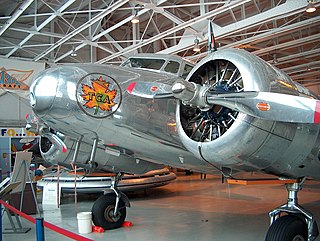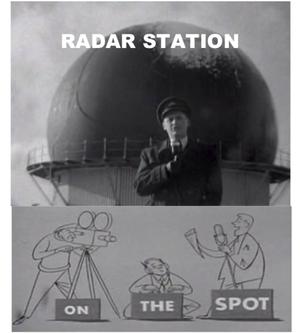
Air Canada Flight 143, commonly known as the Gimli Glider, was a Canadian scheduled domestic passenger flight between Montreal and Edmonton that ran out of fuel on Saturday, July 23, 1983, at an altitude of 41,000 feet (12,500 m), midway through the flight. The flight crew successfully glided the Boeing 767 to an emergency landing at a former Royal Canadian Air Force base in Gimli, Manitoba, which had been converted to a racetrack, Gimli Motorsports Park. It resulted in no serious injuries to passengers or persons on the ground, and only minor damage to the aircraft. The aircraft was repaired and remained in service until its retirement in 2008. This unusual aviation accident earned the aircraft the nickname "Gimli Glider."

The Avro Canada C102 Jetliner was a Canadian prototype medium-range turbojet-powered jet airliner built by Avro Canada in 1949. It was beaten to the air by only 13 days by the de Havilland Comet, thereby becoming the second purpose-built jet airliner in the world, while both were preceded by the Nene Lancastrian, and the Nene Viking, both of which were conversions of piston engine airliners. The name "Jetliner" was chosen as a shortening of the term "jet airliner", a term which is still in popular usage. The aircraft was considered suitable for busy routes along the US eastern seaboard and garnered intense interest, notably from Howard Hughes who even offered to start production under license. However, continued delays in Avro Canada's all-weather interceptor project, the CF-100 Canuck, led to an order to stop working on the project in 1951, with the prototype Jetliner later cut up for scrap.

The Bristol Type 175 Britannia is a retired British medium-to-long-range airliner built by the Bristol Aeroplane Company in 1952 to meet British civilian aviation needs. During development two prototypes were lost and the turboprop engines proved susceptible to inlet icing, which delayed entry into service while solutions were sought.

The Vickers Viscount is a British medium-range turboprop airliner first flown in 1948 by Vickers-Armstrongs. A design requirement from the Brabazon Committee, it entered service in 1953 and was the first turboprop-powered airliner.

The Vickers Vanguard was a short/medium-range turboprop airliner designed and produced by the British aircraft manufacturer Vickers-Armstrongs.

The De Havilland Canada DHC-8, commonly known as the Dash 8, is a series of turboprop-powered regional airliners, introduced by de Havilland Canada (DHC) in 1984. DHC was bought by Boeing in 1986, then by Bombardier in 1992, then by Longview Aviation Capital in 2019; Longview revived the De Havilland Canada brand. Powered by two Pratt & Whitney Canada PW150s, it was developed from the Dash 7 with improved cruise performance and lower operational costs, but without STOL performance. The Dash 8 was offered in four sizes: the initial Series 100 (1984–2005), the more powerful Series 200 (1995–2009) with 37–40 seats, the Series 300 (1989–2009) with 50–56 seats, and Series 400 (1999–2022) with 68–90 seats. The QSeries are post-1997 variants fitted with active noise control systems.

Trans-Canada Air Lines was a Canadian airline that operated as the country's flag carrier, with corporate headquarters in Montreal, Quebec. Its first president was Gordon Roy McGregor. Founded in 1937, it was renamed Air Canada in 1965.

Trans-Canada Air Lines (TCA) Flight 831 was a flight from Montréal–Dorval International Airport to Toronto International Airport on November 29, 1963. About five minutes after takeoff in poor weather, the jet crashed about 32 km (20 mi) north of Montreal, near Ste-Thérèse-de-Blainville, Quebec, Canada, killing all 111 passengers and seven crew members. The crash was the deadliest in Canadian history at the time. It was also the deadliest crash of a DC-8 at the time, and, as of 2022, the sixth-deadliest.
Joseph Bernard Devlin was a French-Canadian film director, producer, and writer who played an important role in the development of French-language film production at the National Film Board of Canada (NFB).

Blake is a 1969 Canadian short documentary film produced by the National Film Board of Canada (NFB). The film was directed by Bill Mason, and his fellow filmmaker Blake James, who pilots his own aircraft and lives by a unique code. Blake is Mason's cinematic testimonial to his friend and his "hobo of the skies" lifestyle.
Grant McLean, CM was a Canadian filmmaker, working as a cinematographer, film director and producer for the National Film Board of Canada (NFB), and serving as its Acting Commissioner through 1966 and 1967.
On the Spot was the first television series made specifically for TV by the National Film Board of Canada, and aired on CBC Television from 1953 to 1955. Each episode reported on a different aspect of life in Canada and was introduced with the line "The National Film Board’s up-to-the-minute report of what’s happening somewhere in Canada”. The series was originated by Bernard Devlin, with Robert Anderson as executive producer.
Fergus McDonell was an English film editor and director. He was nominated for the Academy Award for Best Film Editing for Odd Man Out (1947), and his film The Hideout received a nomination for Best British Film at the 1949 BAFTA Awards.
The Bangladesh Aeronautical Center, or BAC is a Bangladeshi state-owned major defense contractor and aerospace, arms, defense and advanced technology company headquartered in Kurmitola, Dhaka. It was formed by the Ministry of Defence in 2011, and is managed by the Bangladesh Air Force.

Birth of a Giant is a 29-minute 1957 Canadian documentary film, directed by Hugh O'Connor and produced by the National Film Board of Canada (NFB) for the Canadian Broadcasting Corporation (CBC) television series, Perspective.

Transpacific Flight is a 1953 Canadian short documentary film, part of the On The Spot series made specifically for television, produced by the National Film Board of Canada (NFB). The documentary involved an account of a flight across the Pacific Ocean in 1953, based on first-person interviews of the flight crew.

Radar Station is a 1953 Canadian short documentary film produced by the National Film Board of Canada (NFB) as part of the On The Spot series made specifically for television. The documentary involved an account of a visit to a radar station while it is involved in a simulated air attack, and is based on first-person interviews of the staff at the radar station.

Screaming Jets is an 11-minute 1951 Canadian documentary film, made by the National Film Board of Canada (NFB) as part of the postwar Canada Carries On series. The film, directed by Jack Olsen and produced by Sydney Newman, depicted the contemporary Canadian and international aircraft in production and on the drawing boards. The film's French version title is Avions à réaction.
Julian Biggs (1920–1972) was a director and producer with the National Film Board of Canada and its first Director of English Production. Over the course of his 20-year career, he created 146 films, two of which were nominated for Academy Awards. His film 23 Skidoo (1964) received two BAFTA nominations, including the BAFTA United Nations award.
Robert Anderson was a Canadian filmmaker who specialized in films about psychiatry, first with the National Film Board of Canada, and then through his own company. He was the first filmmaker to create truthful, objective films about mental health and addiction, and to make films of this type using actual patients, doctors and hospitals, rather than actors in reconstructions. His most famous film is Drug Addict, which caused a furor when it was banned in the United States. Anderson was co-founder of the Canadian National Science Film Library, and he played a large role in bringing television to the Canadian House of Commons.













